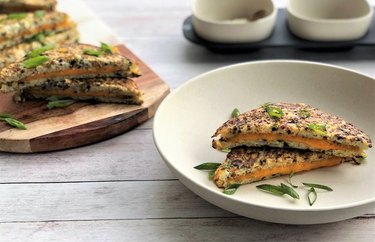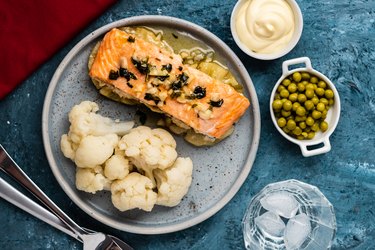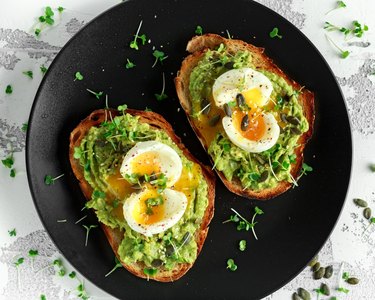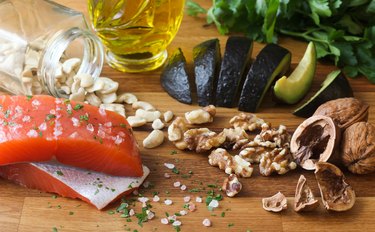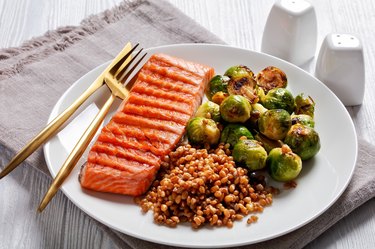
Trying to shed a few inches and get toned, but not sure where to start? Look no further! Here are some tips plus a general meal plan that will work for any person — regardless of your assigned sex at birth — if you're looking to lose weight and gain muscle.
A Note on Language
Here at LIVESTRONG.com, we try to use inclusive language when it comes to sex and gender. Some dietary guidelines distinguish between nutritional needs for women and men, but nutrient requirements are usually more accurate when tailored to a person's individual calorie needs, activity level and overall health.
Still, we understand many people look up this information in relation to their own sex and gender, so we have used the word "women" throughout this article.
Video of the Day
The Benefits of Losing Fat
More than two out of three adults in the United States have overweight or obesity, according to the National Institute of Diabetes and Digestive and Kidney Diseases (NIDDK).
Video of the Day
Losing even a modest amount of weight, like 5 to 10 percent of your body weight, results in health benefits like better blood pressure, blood sugar and cholesterol levels, according to the Centers for Disease Control and Prevention (CDC). Plus, it may help you reduce your risk of certain diseases associated with weight (such as diabetes and heart disease), per the U.S. National Library of Medicine (NLM).
Weight Loss for Women
You're not mistaken if you've ever felt like losing weight is sometimes harder for women than it is for men.
There are a number of biological reasons for this, according to the Women's Health Research Institute. For starters, people assigned male at birth (AMAB) tend to have more lean muscle and a lower body fat percentage than people assigned female at birth (AFAB), which makes their resting metabolic rate higher. And the higher your resting metabolic rate, the more calories your body is able to burn in a day, per the American Council on Exercise (ACE).
The bodies of AFAB people tend to store fat in the hips, thighs and buttocks, and those areas have proven to be a little more stubborn when it comes to fat loss and muscle gain. Female hormones also make it more likely for excess calories that aren't burned to be stored in the body as fat, which occupies more space than muscle does.
What Should a Woman Eat to Lose Weight and Gain Muscle?
First things first: While it can be tempting to go on a crash diet to try to lose weight quickly, it's just not a good idea, according to the Cleveland Clinic. Fad diets, cleanses and rapid weight loss in general can bring on a slew of dangers, and chances are that you'll gain the weight back as soon as you resume eating normally.
Instead, aim to take a slower, more gradual approach to weight loss, and lose 1 or 2 pounds per week, per the CDC. To do that, you need to cut down on your daily calorie consumption by 500 to 1,000 calories to lose up to 2 pounds per week, according to Harvard Health Publishing.
Avoid letting your daily calorie intake fall below 1,200 calories, since that could cause you to lose out on essential nutrients. If a 1,200-calorie diet creates a deficit of more than 1,000 calories and you're exercising on top of that, weight loss may start to stall. Adaptive thermogenesis occurs right after the initial weight loss — when your metabolism slowly adjusts to match your low-calorie intake, according to an October 2016 article in Current Obesity Reports.
What Foods to Eat for Weight Loss and Muscle Gain
It's not just the number of calories that matters. A meal plan for weight loss and muscle gain needs to look at the quality of the calories, too, according to Harvard Health Publishing. Not all calories are created equal — a calorie of junk food is not equal to a calorie of a healthy food. While the former usually has little to no nutrition, the calories in the latter are usually accompanied by essential nutrients that your body needs.
You want variety in each meal; a good diet is a balanced, colorful diet, according to the CDC. Opt for high-quality foods that provide you with both calories (energy) and nutrition. This includes:
- Fruits
- Vegetables
- Whole grains like brown rice and quinoa
- Good fats like avocado and nuts
- Lean proteins
Your body can multitask — that is, you can build muscle while losing weight.
"Food doesn't make you gain muscle. You need to exercise; you need to lift weight for that," says Nancy Clark, RD, CSSD, best-selling author of Nancy Clark's Sports Nutrition Guidebook.
"But the body needs the tools to build the muscle, and that would be protein-rich foods like Greek yogurt, chicken, turkey, tofu, beans — any protein-rich food will build and repair. Carbs, like grains, fuel the muscle to do the exercise," Clark says. Find out more with this weight-loss meal plan for athletes.
Of course, the rate of muscle growth is different for everyone during a strength-training program, according to ACE. Age, sex, hormone levels and overall genetic makeup all contribute to the rate of your muscle growth. You'll probably be able to see some growth in three to six months.
Tip
According to the Department of Health and Human Services’ Physical Activity Guidelines for Americans, it is recommended that adults get at least150 minutes of moderate-intensity physical activity. Plus, adults should muscle strengthening activity at least two days out of each week.
What Foods to Cut Out to Get Lean
Avoid certain foods if your goal is to get lean, per Harvard Health Publishing, including:
- Refined grains
- Highly processed foods and snacks
- Refined sugar
- Sugary foods and drinks
- Fried foods and foods with trans fats or significant amounts of saturated fat
That said, keep in mind that a too-restrictive diet just isn't realistic for long-term weight loss and maintenance. "The minute you say 'Don't eat apples,' the person starts craving apples," Clark says.
Lean Meal Plan Ideas
It's a good idea to visit a dietitian for a meal plan that is customized to your age, preferences, lifestyle, medical conditions and food allergies. A weight-loss plan for a woman over 60 may be different than the weight-loss plan for a woman over 40, for instance — a dietitian can help you navigate the best path for you.
In the meantime, Clark recommends that you get at least three or four different kinds of foods with the meal. "You would need some sort of protein to build and repair your muscles, some sort of grain to fuel your muscles, some sort of fruit or veg for vitamins and minerals and some kind of calcium-rich food for your bones," she says.
Also, make sure to drink enough water.
There's a significant link between obesity and inadequate hydration, according to a study published in July 2016 in The Annals of Family Medicine. Harvard Health Publishing recommends sticking with the 4- to 6-cup rule, but you should definitely increase your intake if you're sweating a lot due to exercise or if it's a hot day.
Breakfast
Here are some lean meal plan ideas for breakfast, courtesy of the National Heart, Lung and Blood Institute (NHLBI):
- Whole-wheat bread with some jelly, shredded wheat cereal with 1 percent milk, orange juice and regular coffee
- Oatmeal (made with 1 percent milk), fruit and coffee
You should also add a protein in there, according to Clark, like eggs or cottage cheese.
And don't forget those good fats! Unsaturated fats — like avocado, nuts and seeds, oils and fish — are necessary and beneficial to your health, per the Harvard T.H. Chan School of Public Health.
Lunch
For your midday meal, try:
- Apple and a roast beef sandwich, made with lean beef, whole-wheat bread, lettuce, tomato and low-calorie mayo
- Baked chicken (without the skin), a vegetable salad with an oil and vinegar dressing and some brown rice
Dinner
Some dinner ideas, per the NHLBI:
- Salmon, a baked potato, carrots and green beans, a dinner roll and some unsweetened iced tea
- Chicken taco (made with a corn tortilla and skinless chicken breast), Spanish rice (without meat), corn, a banana and some coffee (made with 1 percent milk)
Strategies for Success
Losing weight can be hard, but apart from eating healthier and exercising regularly, there are some changes you can make in your daily habits to make it easier.
How to Gain Control
For instance, it's recommended that you pay attention to what you eat and how much you eat; instead of eating mindlessly, eat only when you're genuinely hungry and stop eating when you're full, according to the Mayo Clinic. Avoid eating while you're working, watching TV or fiddling with your phone, since you're less likely to notice signs from your body telling you that you're full.
Try examining your motives towards the food you eat. It's possible that you're eating out of boredom or in response to an emotional trigger, like stress or sadness. If you are in fact emotional eating, start replacing that habit with a healthier one.
It can also help to get support from friends and family, or join a support group.
How to Meal Prep for Muscle Gain and Fat Loss
When it comes to weight loss, eating a small meal every 3 to 4 hours is an effective way to get a steady metabolism and get the body in a continued anabolic state — a muscle building state, according to the National Academy of Sports Medicine (NASM).
Meal prepping will get you to stick to any type of nutrition plan since it helps control calorie intake, provides structure and it eliminates meal guesswork. It allows much more control over what you put in your body compared to eating out.
Clark suggests that you just write down what you feel like eating for a few days or the week (and make sure the meals include all the food groups, especially protein), quickly calculate calories for each meal, create a shopping list and take a few hours to prepare these meals that you can just heat up throughout the week.
- National Institute of Diabetes and Digestive and Kidney Diseases: "Overweight & Obesity Statistics"
- Centers for Disease Control and Prevention: "Losing Weight"
- Appetite: "Psychological Benefits of Weight Loss Following Behavioural and/or Dietary Weight Loss Interventions. A Systematic Research Review"
- Women’s Health Research Institute: "Why is it Harder for Women to Lose Weight?"
- American Council on Exercise: "Resting Metabolic Rate: Best Ways to Measure It—And Raise It, Too"
- Cleveland Clinic: "Is It Bad to Lose Weight Too Quickly?"
- Current Obesity Reports: "Changes in Energy Expenditure with Weight Gain and Weight Loss in Humans"
- Harvard Health Publishing: "There's No Sugar-Coating It: All Calories Are Not Created Equal"
- Department of Health and Human Services: "Physical Activity Guidelines for Americans"
- American Council on Exercise: "How Muscle Grows"
- The Annals of Family Medicine: "Inadequate Hydration, BMI, and Obesity Among US Adults: NHANES 2009–2012"
- Harvard Health Publishing: "How Much Water Should You Drink?"
- National Heart, Lung and Blood Institute: "Menus"
- Harvard T.H. Chan School of Public Health: "Fats and Cholesterol"
- Mayo Clinic: "Weight Loss: Gain Control of Emotional Eating"
- National Academy of Sports Medicine: "How to Meal Prep for Weight Loss"
- U.S. National Library of Medicine: "Weight Control"

